| |
“But also, there’s always something deeper underneath, an agenda of why we’re making the movie; a soul to the film, like an inner arc. In this case, it’s Ralph’s inner arc of doubt. You know that feeling of being oppressed by doubt and feeling liberated by it. That made me want to make the film, his speech about doubt, basically.” |
| |
Director Edward Berger on writer Peter Straughan’s screenplay* |
I can think of no better way to underpin a film about the ludicrous tradition of voting for a man to become the infallible representative of God on Earth than a leading character’s doubt. Still my favourite exchange in the sit-com Father Ted – a series which never directly criticises or is meanspirited about the Catholic Church, no small feat – is the one between a visiting bishop and the young, not quite all there, Father Dougal. Dougal is asked if he has any doubts about aspects of belief…” Dougal says “Well, you know the way God made us all, right? And he's looking down at us from heaven and everything? And then his son came down and saved everyone and all that? And when we die we're all going to go to heaven?” Bishop O'Neill says “Yes. What about it?” Dougal replies, “Well, that's the bit I have trouble with.” Doubt is the only way I too can deal with people who profess a calling from or a direct relationship with the creator of the Universe. Think of the colossal arrogance of such claims. It’s like having Tom Cruise on speed dial. I tried to imagine one of the most famous people in the world and unsurprisingly, they were all scumbags. Cruise got in by default as a decent man according to friends of mine who’ve worked with him. I’m reminded of Phillip K. Dick’s lovely line from his novel The Transmigration of Timothy Archer… (and regular readers will have no doubt heard me quote this before) “They call people who talk to God, pious. They call people to whom God speaks lunatics.” Let’s stay with sit-coms for a moment before I launch into why Conclave is one of the best films of last year, something Slarek has already flagged in his end of the year review.
A person of great power retires, dies or concedes to a takeover. Prospective candidates line up for a shot at the title but are slowly whittled down to one, usually a surprising but inevitable choice once all the others have been dismissed for some kind of impropriety. This is not a new narrative. It is the dominant one in the ultimate episode of the BBC’s timeless comedy classic Yes, Minister written by Jonathan Lynn and Antony Jay. The only remaining candidate in that instance to no one’s surprise is MP Jim Hacker who goes on to become the UK Prime Minister for two more series of Yes, Prime Minister, both as brilliant as their forbears. It’s fair to say that conventional action is lacking in these narratives and in Conclave’s case drama is contained in a superb, slow burning and subtext-heavy screenplay and unfaltering, assured and intelligent direction. Men talk to men (and one woman) in hallowed hallways until conclusions are reached. Film cognoscenti speak of ‘tone’, a thread of intent and mood that can seep between the sprockets of a film and tonally, everything about Conclave is in perfect balance. If, like myself, you usually approach anything to do with religious faith with doubt not so much on your sleeve but the actual fabric from which your jacket is made, then you may just find all these machinations rather silly. Which man in odd vestments who professes a faith in the faintly ridiculous will become the Believer-in-Chief of some of the most dangerous ‘truths’ mankind ever dreamt up to control the populace? But that’s not what cinema is about. The sincerity of the men in question is not in doubt. Cardinal Lawrence has enough doubts to satisfy non-believers in the audience but that’s not even the point either. This is a story. Do you trust the story? Do the actors convince you? Does the direction beautifully carry you from one incident to another making you hunger for the next revelation? Answers to those questions, from where I’m sitting, are authentic and enthusiastic ‘Yes’s.
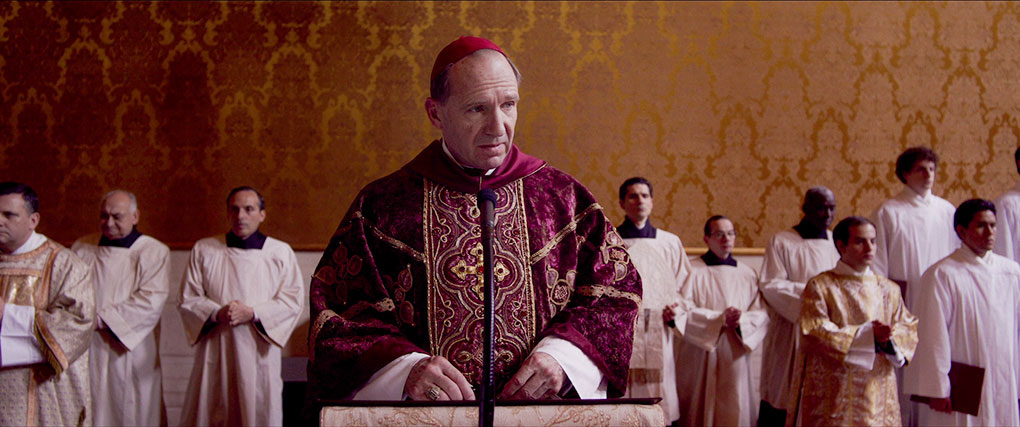
While I’ve already provided a synopsis of sorts, I’ll fill in a few details. At the now deceased Pope’s request, Cardinal Lawrence is put in charge of the conclave, a gathering of the highest Catholic cardinal ranks to vote for one of their own as the successor to the passed on pontiff. Globally speaking, it is a unique role, a powerful one to be sure, the leader of a myth-sustaining club or cult of 1.3 billion souls. It is not a democratic vote and this leader holds no political sway despite the one he (invariably a he) has over his colossal flock. I worked on a feature documentary a few years ago about Pope Francis’ attempts to alert people to the very real dangers of climate change. In that documentary, he even stated that the Bible contained at least one myth… He says, “Obviously the biblical story of creation is a mythical form of expression to explain our history.” Now if I had to have one, that would be my kind of Pope. Cardinal Lawrence knows that there are a number of frontrunners for the role but this necessitates the endless series of voting that the other cardinals have to submit to. The higher number of votes required for a close to unanimous judgement is always split so many ways, even including a few votes for Cardinal Lawrence himself. He has one staunch fan, a newcomer, a war cardinal whose soft spoken manner and voice belie his determination never to change his vote. After each round, the votes are burned ceremoniously which is why the Vatican chimney belching out smoke heralds either more voting to come or the triumph of the choosing of the new Pope. But Lawrence is a man with wavering faith and tries to extricate himself from being considered but as fate would have it, his tally steadily rises if not to the heights necessary to put him in the big chair. Slowly, reasons are found and plots hatched to eliminate some of the favourites and the efforts of an extremist suicide bomber in Vatican City tip the scales of opinion against another faith and towards a pro-active, anti-terrorist candidate… As Slarek mentioned in his capsule review, the outcome of the drama is not difficult to foresee. What’s wonderful about the film, to grind the cliché into the ground, is the journey getting there.
Central to the film is Cardinal Lawrence. Ralph Fiennes is an actor of rare authority interspersed with vulnerability. He can play the mundanity of evil (Schindler’s List’s monstrous Second Lieutenant Amon Göth) or, if you like, the absurd theatricality of evil (Lord Voldemort in the Harry Potter series). Let also give a shout to Harry Waters, the English crime lord reluctantly in Belgium, not quite as evil but deliriously foulmouthed in In Bruges. It’s the range of his characters that’s a blessing in a great career. I had such joy imagining Harry dealing with electing a new Pope. It’s that diversity that gives an actor’s career some pizzazz. “Leave that c**t-fucking cardinal out of it! That’s going overboard mate!” In some fashion, the entire film is Cardinal Lawrence’s journey. Heavy is the load on his shoulders but as he slowly accepts the difficult and uneasy conclusion of the process to which fate has delivered him, the insignificant act of opening a window is a philosophical and metaphorical coup de grace. The simple and mundane can become deified by cinema’s attention to detail and a director who knows precisely where to put his camera and an editor whose sensitivity knows just how long to make the shot last. As mundane as it is, I am in awe of that final shot for its timing, its content and its cut to black. You may appreciate it as I did or the mundanity may be too much for you but rest assured, this is filmmaking on a higher level.
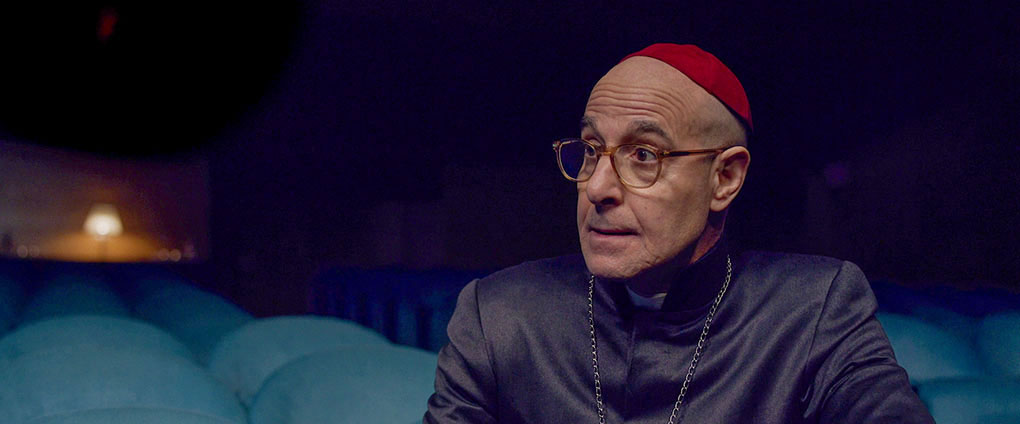
Among the many pleasures of the film are some of the supporting roles played by well-known actors whose superior craft enables each to speak volumes with a paucity of movement or indeed dialogue. The front-runner at the start of the voting procedure is Stanley Tucci as Cardinal Aldo Bellini. This self-effacing, liberal character makes a change from Tucci’s more showy roles and he pitches it just right as a convincing popular choice but also, as we are at the start of the voting, a doomed one. Nice guys don’t necessarily finish last but usually close to it in this case. Each of the other candidates reveal their disqualifying flaws in slow drip, fascinating ways. It’s also lovely to see John Lithgow back on the big screen playing Cardinal Joseph Tremblay, a Canadian moderate who has schemes of his own. By far the biggest casting surprise was seeing Isabella Rossellini as Sister Agnes, the cardinals' head caterer and housekeeper. I can’t imagine how she might have been drawn to the role simply by reading the script. Her part is almost entirely wordless but I guess this aspect has challenges all of its own. She is mesmerising in the part not least because her performance is a losing battle to hide her emotional disdain and revulsion at those unworthy men around her. It’s true, she gets to verbally deliver a truth bomb at the appropriate time but it’s that stoic ‘maintaining an even strain’ that I enjoyed most about her performance. Two more stand outs are Lucian Msamati – ten years ago, he was the first black actor to play Iago on stage, perhaps groundbreaking at the time and nowadays, one hopes, unremarkable. Are we getting close to perceiving skin colour as we do hair colour?** Or are we still not out of those woods yet? Msamati plays Cardinal Joshua Adeyemi, a popular Nigerian candidate with a conservative stance. His fate is by far the most heartfelt because of a secret kept tightly under wraps. He must have lived like he had been sitting on an unexploded bomb for decades. How does one live like that exposed to the higher reaches of the Catholic church? Secondly, there’s the mild and gentle but steel-willed Cardinal Vincent Benitez played by Carlos Diehz as a Mexican archbishop who was working in war-torn Afghanistan. Despite his demure standing, a newbie in such hallowed company, he makes his presence soundly felt.
Conclave is a superb example of how to achieve artistic and cinematic success with the highest level of filmmaking craft to tell a visually subtle, understated and predominantly physically inactive story. Kudos firstly must go to Peter Straughan’s superb interpretation and adaptation of Robert Harris’ source novel. With a screenplay this good, you’re already ahead of the game. Edward Berger’s direction is unfussy and precise and you get the impression that this man knows how to get out of the way of the tale he’s telling. Berger is aided by quietly restrained, and in some instances beautiful cinematography, the work of DoP Stéphane Fontaine. The use of in-frame sources of lighting, presumably partnered by camera sensors able to handle such low levels of light, is marked and extremely effective. There’s a gentleness to the light that serves the character’s faces well. It doesn’t hurt that the film was shot in Rome and all the Vatican interiors faithfully recreated at Cinecittà Studios. Whoever was responsible for replicating the look and reflective qualities of marble should get a strong pat on the back. Watching the film, you never question whether it was actually shot at the Vatican itself, so good are the sets.
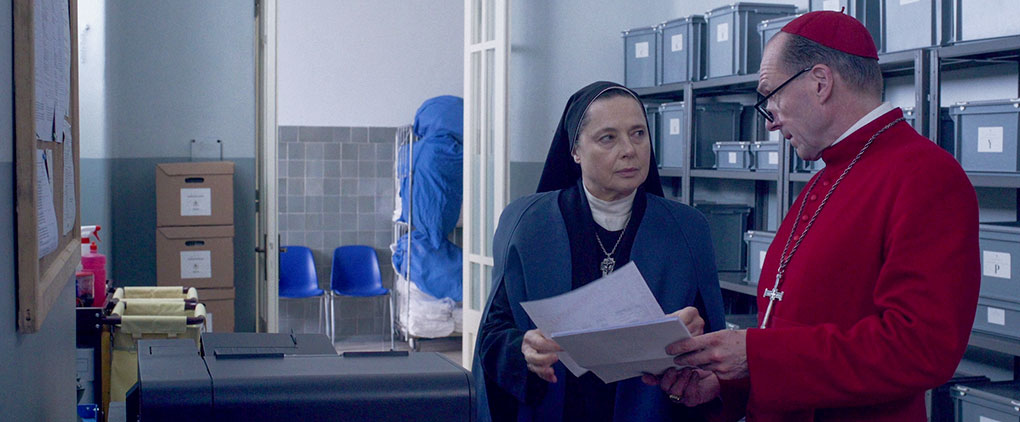
Adding to the mix is Nick Emerson’s tightly controlled editing. Every conversation is cut in such a natural way, you are barely conscious of the edits. Each shot earns its place in the narrative and Emerson’s work sometimes highlights an image which on the face of it does not serve the story until certain thoughts are evoked by such shots. What image best tells you that the cardinals are now having to be shut in behind closed doors for however long it takes until a Pope is duly elected? How about approximately 90 cigarette butts strewn in a pile in the exterior quadrangle? Inspired. You then realise these images are all the result of a well utilised editor’s toolkit. There is a masterful cut at around 75 minutes in. Lawrence has been granted access to Sister Agnes’ computer. She leaves him to it. Lawrence is in mid-shot to the right of frame. As he starts to move to the left, we cut to Lawrence closer in but moving to the right of frame. This should jar but it doesn’t. It’s a terrific answer to the problem of getting him closer to the computer monitor and the jarring is minimised by the scraping of his chair on the sound track. I have already highlighted my enthusiasm for the edit of the final shot. Volker Bertelmann’s score is unusual for being neither ‘religious’ nor symphonic but in several instances quite experimental and it fits the film like an overused proverb. Finally, there is the sound. Conclave is a very quiet, intimate film. Conversations sound like close-mic recorded bass whispers and this style also suits the film wonderfully well. Voices are rarely raised and the sound design bubbles like a pressure cooker timing to perfection when to let some steam escape. Conclave is in a class of its own and surprisingly involving. Highly recommended.
The film is presented in 2K 1080p HD on Blu-ray and on 4K 2160p on a separate UHD in this Black Bear dual format package, making it easy – and revealing – to directly compare the two (for technical reasons, the screen grabs included here have been taken from the Blu-ray). Framed in the film’s original aspect ratio of 2.40:1, the transfer is unsurprisingly crisp and clean on both discs – when you shoot and edit digitally, there is no earthly reason why there should be even a speck of dust or damage. Detail is inevitably sharper on the UHD, though not by the degree that I was expecting, which in part is a testament to how crisp it looks on the Blu-ray. The real difference here lies in the image brightness, which is substantially lower on the UHD than on the Blu-ray. Now I should note that it not unusual for UHD transfers to not be as obviously bright as their Blu-ray equivalent, as the use of HDR tends to widen the contrast range to reveal detail in the shadows that might be otherwise lost on a similarly graded Blu-ray, as evidenced in Indicator’s recent UHD releases of Thirst and Harlequin. That’s not the case with Conclave, on my system, at least. Even with my living room curtains drawn and the lights off, I struggled to see shadow detail on the UHD transfer that was clearly visible on the Blu-ray, and given that most of the film takes place inside the halls and rooms of the Vatican with its windows shuttered for security, a lot of this film takes place in darkened rooms. How much of this is down to the decision to use 10-bit HDR PQ instead of the current gold standard of Dolby Vision 12-bit HDR is not something I could speculate on with any authority, but when it comes to the picture quality, I have to admit to preferring the Blu-ray to the UHD.
Both discs have DTS-HD Master Audio surround soundtracks, and while we might bemoan the absence of a Dolby Atmos track (Black Bear does seem to have sidestepped Dolby completely with this disc, perhaps due to the cost of licensing its technology?), the included DTS track is an excellent one, which is particularly important given the crucial role played by sound in this film. The clarity and tonal range are both superb, capturing the quietest noises and whispers with precision, and making inclusive use of the surround speakers for location ambient sounds. When a sudden loud noise occurs late in the film (I’m not going to reveal what makes it, but if you’ve seen the film you should know the moment to which I am referring), it’s beautifully captured here without even the smallest hint of distortion.
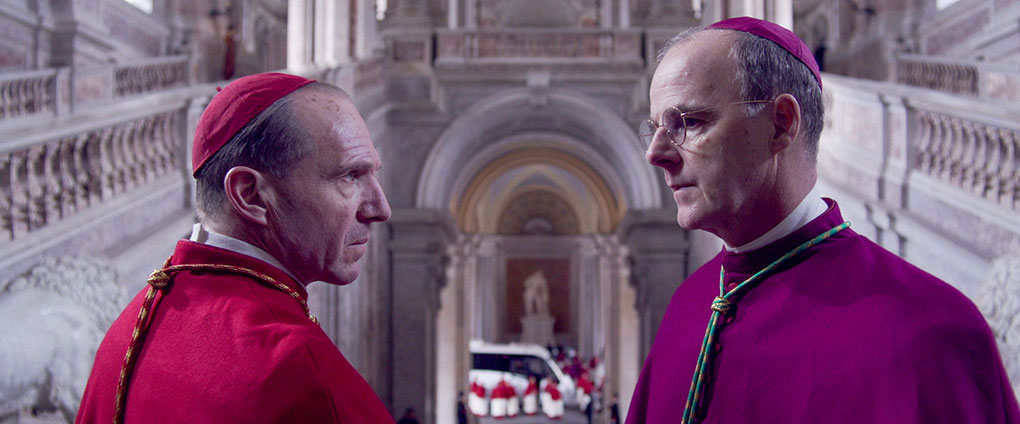
Also included is an audio descriptive track in DTS-HD Master Audio 2.0 stereo. Despite Conclave being a dialogue-heavy film, this track is impressively thorough, and even includes translations of the non-English language dialogue, which is spoken over the film soundtrack in a way that is clear but allows listeners to discern the language being spoken by the actors. Nicely done.
Optional English subtitles kick on by default for all the non-English language dialogue – Italian, Latin and Spanish are all spoken – and optional English subtitles for all dialogue for the hearing impaired are also available. One small nitpick I have with the latter is that they translate all of the non-English dialogue without ever indicating what language is being spoken, or indeed that the characters are not speaking English, which may prove confusing for the hearing impaired viewer who is also attempting to lipread.
Commentary by director Edward Berger
Yes, there are a handful of dead spots, but this matters little when what is said is as informative and enthralling as this superb commentary by director Edward Berger. There’s none of that “I love this” fawning that blights so many filmmaker commentaries of more recent films here, just a wealth of detail on the making of the film, from being first presented with Peter Straughan’s script by producer Tessa Ross (“a wonderful producer,” Berger tells us, with “the biggest heart that you can imagine”) and the five year process of developing the project, to selecting the cast, technical details of the shoot, and the thinking behind specific shot choices and editing decisions. He repeatedly acknowledges the influence of director Alan J. Pakula’s 1970s conspiracy thrillers (Klute, The Parallax View, All the President’s Men), reveals that he and Ralph Fiennes were in complete sync on the notion that the film was primarily a journey of doubt, praises the work of costume designer Lisy Christl (without whom he claims he wouldn’t want to make another film), and he explains his reasons for casting first-time film actor Carlos Diehz as Cardinal Benitez alongside a quartet of established stars. He talks about working with composer Volker Bertelmann to get the right tone for the film, his interest in juxtaposing the archaic with the modern, shooting in a variety of locations in Rome and occasionally having to expand or enhance them with built sets or CGI, the challenge of going from a film with little dialogue (All Quiet on the Western Front) to one that is primarily dialogue driven, and so, so much more. He even provides details on the camera and lenses used and his personal focal length preferences. A compelling and essential companion to the film.
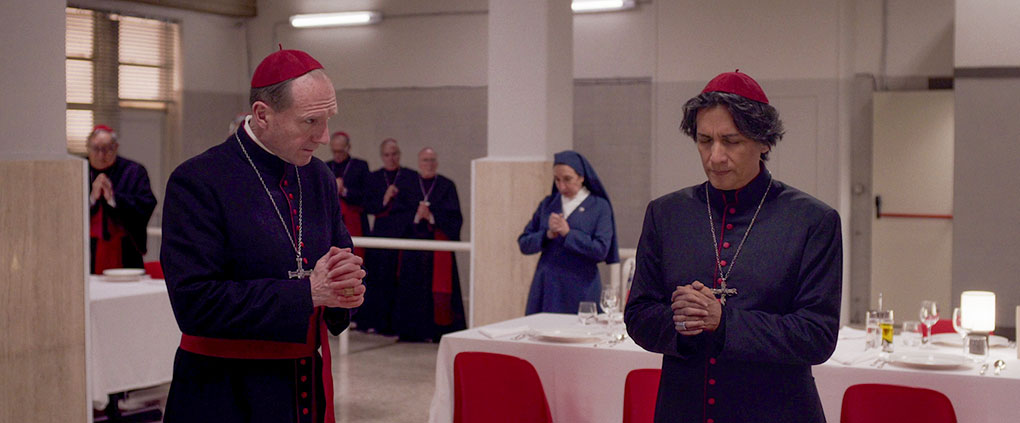
Sequestered: Inside Conclave (16:48)
A standard but well-enough assembled EPK featurette that blends interviews with director Edward Berger and the lead actors with behind-the-scenes footage of the shoot. If you listen to Berger’s commentary first, you’ll already have heard most of the comments that he makes here, and while it’s always nice to hear the actors explain what attracted them to the project, there aren’t any major surprises.
A terrific film in a solid if rather threadbare UHD/Blu-ray package. That the transfer is pristine is unsurprising, but the difference between how the image is graded on the UHD and the Blu-ray did catch me out a little, and as I stated above, I actually prefer the Blu-ray to the UHD on this score. The EPK is of interest for the behind-the-scenes footage and the brief interviews with the director and actors, but the real jewel here is the Edward Berger commentary track, which delivers a ton of information on the film and its making without a whisper of ego on Berger’s part. That he talks about sequences he shot for an abandoned opening scene and suggests that they may be included on this disc seems to leave the way open for a later special edition release, but when or if we’ll see that is anybody’s guess. In the meantime, this will do nicely, but when it comes to the choice between the Blu-ray and the UHD, I’d go with the former, although you do get both in the UHD package.
** For that trenchant analogy, I’m indebted to Sam Harris and his Making Sense podcast.
|